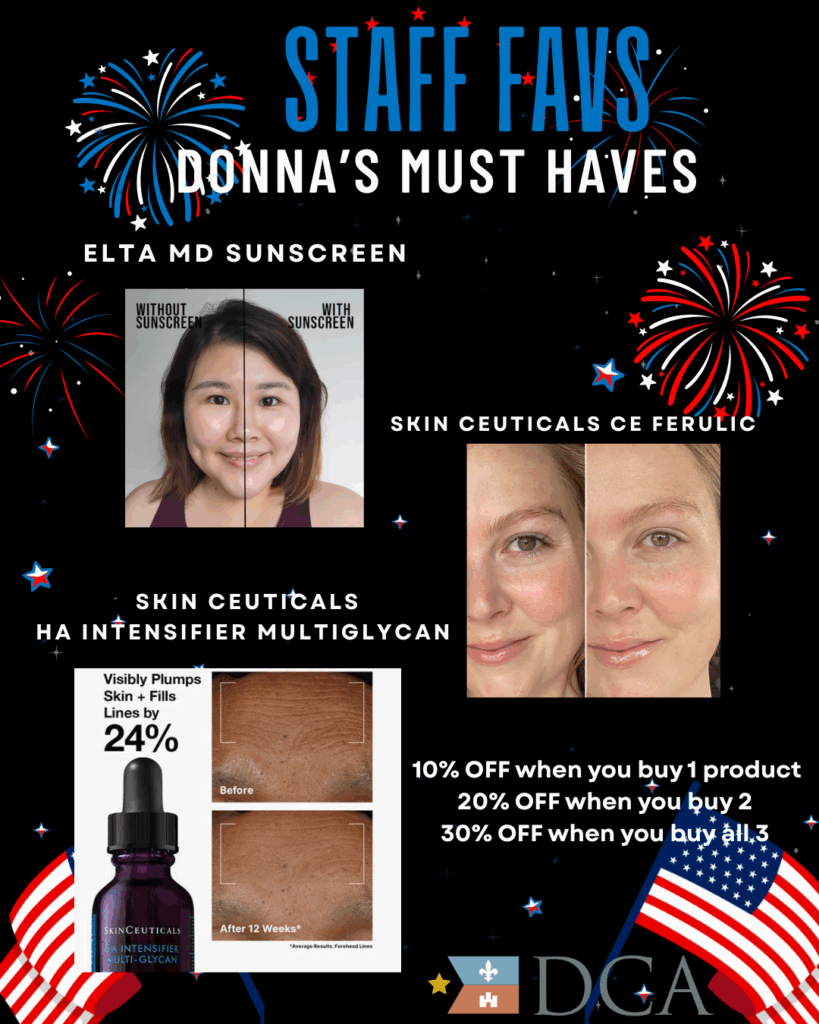For almost as long as human civilizations have existed, body art has been an important form of communication and self-expression. However, when the permanency of tattoos becomes problematic, many people choose to have them removed. At the Dermatology Center of Acadiana in Lafayette, LA, our experienced dermatologists will develop the perfect tattoo removal plan for you.
How Does Tattoo Removal Work?
Currently, laser tattoo removal is the only true non-invasive solution to unwanted tattoos. Prior to now, the alternatives included excision surgery and carbon dioxide lasers, both of which were invasive and carried the possibility of significant scarring. While new technologies such as shorter pulse-duration lasers and removable tattoo inks are on the horizon, laser removal is currently the least invasive option on the market.
The laser removal process begins by breaking up the tattoo particles with the laser. This process is repeated until the particles are no longer visible. After the particles are broken up, they are removed by the body and eliminated through the skin. Any particles that are still too large to be eliminated by the body will require repeated treatments.
The Science of Tattoos
It is important to understand the science behind tattoos and how they maintain their permanency in your skin. Learning about tattoo inks, how they are made, and how they get into your skin’s multiple layers will help you understand how they are removed. It is also important to know how your body’s immune system is involved in both the receiving and removal of tattoos.
Tattoo Ink: What’s in It?
Tattoo ink is made of a carrier solution that moves the pigment, or colorant, to where it is supposed to go. Typically, there are two options that tattoo artists work with: dyes or pigments. Most colorants are pigments created from metals, which do not require a chemical reaction to remain permanent. In contrast, dyes do need to react with the chemistry of the skin in order to keep their color.
Either way, the colorant is dissolved into a carrier, which is a fluid that is typically made from distilled water or a form of alcohol. Carriers may also contain witch hazel or glycerin. It is always prudent to do your own research when determining the chemicals used by manufacturers or by tattoo artists who mix their own inks.
The Dermis and Epidermis
Only two of your three layers of skin are involved in tattoo placement. The first layer, the epidermis, is the outer layer that acts as a waterproof barrier to the outside world. It protects from harsh weather conditions, intruders such as bacteria and viruses, and exposure to ultraviolet radiation. Since this layer is the first line of defense, it is also exposed to the most potential for damage.
The dermis is the second, deeper layer, where your senses of touch, pain, and pressure are felt. This layer also contains hair follicles and sebaceous glands. The oils produced in this layer support the skin’s suppleness and strength, which in turn acts as the body’s shock absorbers, cushioning it from stressful environments.
How Tattoos Adhere to Skin
A tattoo penetrates through the epidermis and deeper into the dermis. As the wound begins to heal where the penetration occurred, the outer layer scabs over. This scabbing process traps the ink underneath.
As white blood cells gather in the area as a response to the unrecognized foreign material, they hold the ink in place and contribute to its permanency. In addition, cells called fibroblasts also arrive at the scabbing site to aid in this process.
The Immune System’s Role
Interestingly enough, the reason your tattoos remain in place is because of your immune response. Similarly, the reason pico tattoo removal works is also because of your immune response. Anytime the body recognizes a particle or organism as foreign it uses white blood cells to mount an attack. This attack catalyzes a chain of events that give tattoos their permanency.
It is the job of these white blood cells, or macrophages, to “eat” the foreign pigment particles. But since the cells are too small to ingest the particles, they relentlessly keep trying despite being able to succeed. Instead, they make a home near the tattoo and when they die others show up to take their place, creating a cycle of constant macrophage activity. This is what keeps ink in its place.
How Long Will the Removal Process Take?
The only true answer to this question is: it depends. There are many factors that can influence how long the process will take, and it can take several sessions for the tattoos to be completely removed. Factors such as the size of your tattoo, its color, and even your age can impact your treatment time. It can also take several weeks between appointments for your body to flush out the particles that are broken up during each session.
Color
It may seem surprising that more sessions may be required for colored tattoos as opposed to black tattoos. This is because black absorbs all wavelengths of light, meaning it doesn’t need specific laser requirements to break up all-black particles. On the other hand, specifically calibrated lasers are required for multiple colors of different wavelengths.
Healing Time
Your body will need time to heal after each session. Remember that the removal process relies on white blood cells to carry away the broken particles as they are created by the laser. For this reason, removal takes place in layers – first the top layers of color, and then the deeper layers. This sort of precision can only take place in phases of healing.
That being said, scheduling treatments too close together can actually result in over-treatment, which comes with unnecessary side effects. It is important to give your body time to heal and consistency with treatment and after-care. It is likely that you will have to wait at least six to eight weeks between sessions.
What To Expect During the Tattoo Removal Process
Before Treatment
If you frequently take any kind of anti-inflammatory pain relievers, you may want to stop using them in the few weeks prior to your first session. These medications, such as Advil and Motrin, can increase bleeding and bruising. In addition, it may also benefit you to cease any habits that may make your skin sensitive, such as skin treatments, tanning, bleaching, or waxing.
This is the time to take special care of your skin. Since you will be receiving laser treatments, you’ll want to be sure that you aren’t exposing your skin to any unnecessary irritants. In addition, remember that smoking slows healing time, so if you are a smoker try to reduce your frequency (or stop altogether) in the weeks prior to your treatment.
During Treatment
Laser removal is considered an outpatient service and doesn’t require any downtime. You should be able to return to your normal activities immediately, and the process should only take a few minutes, depending on the size of your tattoo. Our trained medical staff will first test your skin’s response to the laser treatment. This is to be sure that the correct energy and pulsation is being used.
Skin numbing agents are available to help minimize any discomfort, but most report that the discomfort is manageable. Our compassionate doctors and staff always make your comfort a priority and will do everything possible to put you at ease during your visit.
After Treatment
Our dermatologists will discuss with you any after-care treatment required. While you will be able to return to work and your normal daily activities after your session, follow-up care is very important for proper healing. It is still important to avoid sun exposure as much as possible. If you experience any inflammation, our doctors may advise you to use an ice pack or apply an antibiotic cream. Keeping the area lightly covered may also help the healing process.
Who Is a Good Candidate for Tattoo Removal?
Our experienced team of dermatologists can develop a personalized plan for your tattoo removal. Nearly everyone who desires this treatment can receive it. As with most medical treatments, there are factors that make certain people better candidates than others. These include things like age, general health, and lifestyle.
Age and Health
If you are immunocompromised in any way, it is best to undergo treatment when your body is at peak immune performance. The stronger your immunity, the more effective the removal will be. In addition, it’s no surprise that mature skin takes longer to recover than younger skin.
Skin Tone and Color
Life isn’t always fair, but in this case, it helps to be fair-skinned. Lighter skin has the advantage of greater contrast between skin color and tattoo color. This makes removal easier since the laser will be more accommodating to contrasting colors. For darker-skinned people, extra caution is sometimes required so that skin discoloration can be avoided. This may mean longer treatments are required.
Tattoo Type
The larger the tattoo, and the more colors it has, the longer it will take to remove. In contrast, smaller, older, or more faded tattoos will take less time to remove. And since black is the easiest color to remove, it stands to reason an all-black tattoo that has faded or is less dense will be removed most quickly.
Lifestyle
Taking care of your skin can certainly increase your odds of successful tattoo removal. It is best to make healthy choices as often as you can, such as eating balanced meals, hydrating adequately, and minimizing stress. Those who live a healthy lifestyle will have greater healing and resilience after laser removal treatments. The idea is to keep the skin as supple and elastic as possible for the most ideal results.
Keep in mind, smoking can cause increased healing time, which means longer time between sessions. In order to give the body its best chance at recovery, it is advised that smokers cut back or quit altogether.
Pre-Existing Health Conditions
If you have any pre-existing skin conditions such as eczema, rosacea, or herpes, you may be more prone to side effects from treatment. However, this doesn’t mean you cannot undergo treatment; it just means that you will need to follow special advice and care from our experienced doctors.
That being said, if you are pregnant or breastfeeding, you may be asked to wait to begin the removal process. Pregnancy can cause changes to the skin, such as photosensitivity, that might increase the risk of side effects.
Call Us Today
Laser removal is typically completed within a few minutes and requires minimal downtime. Currently, this treatment is the best option for nearly anyone who desires to have a tattoo removed. Our compassionate dermatologists and staff look forward to the opportunity to help you reclaim your natural skin. Call the Dermatology Center of Acadiana in Lafayette, LA to schedule your consultation today.

